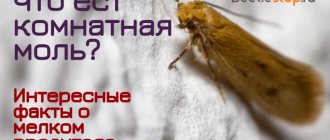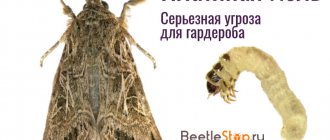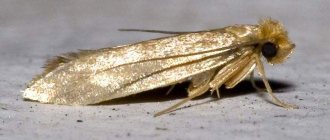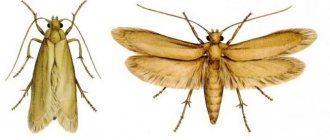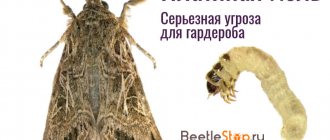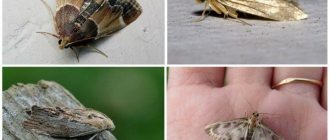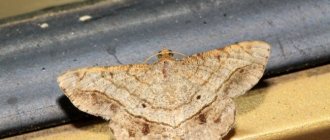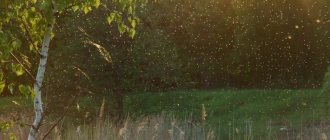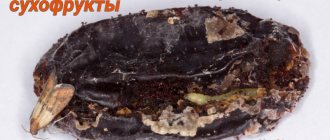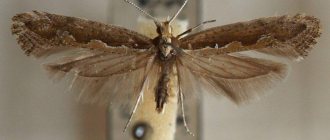A moth's lip is not stupid. She is not interested in cheap synthetics - give her fur. Silk and wool, natural and expensive, will also work. If she’s really hungry, she won’t disdain feathers and cotton. How to protect your most valuable things from an insatiable pest?
To win the war against clothes moths, you need to carefully study its preferences and find vulnerabilities, and then deprive it of pleasures and strike where it hurts the most. Only then will it be possible to get rid of the voracious insect once and for all.
Who eats our clothes
The clothes moth (also known as the house moth) is a small butterfly with golden wings with fringed edges. However, she is not the main enemy of our things. Irreparable damage to the wardrobe is caused by its larva - a transparent white caterpillar up to 1 cm long. The caterpillar is very lazy, inactive, but when it needs to find food for itself, it begins to move.
When you see a moth flying around the house, you don’t even have to run after it, trying to swat it. The fact is that only males or females who have already laid eggs fly. They will no longer bring you harm, and they will soon die themselves. You need to hunt for their eggs and larvae.
How moths get into our houses and apartments
The easiest way is through an open window or door. However, clothes moths are also capable of entering a home through a narrow gap. The flying butterfly finds suitable conditions for reproduction and food and lays eggs there.
If you brought an antique or simply used sofa from somewhere, it is quite possible that there were already eggs or moth larvae in its upholstery. The same goes for used clothes.
Clothes moth larvae can come to us, although rarely, through the fur of domestic animals.
Features of reproduction
An insect that finds itself in a living room or has occupied crops begins to actively reproduce. This process takes place in four stages. First, the female lays eggs. They can be collected in one place or scattered throughout the area, which will later be occupied by parasites.
Those who do not know what moths eat will be interested in the fact that during the development and growth of the caterpillars, the previous generation of pests gradually dies out. This explains the noticeable decline in the number of flying butterflies.
Actively feeding larvae begin to increase in size. A well-fed individual pupates and spends about two months in its cocoon. After this period, a moth appears from there, looking like a chaotically flying butterfly.
If eggs are laid in early autumn, the larvae have to overwinter in woven cocoons. Individuals found inside living quarters continue to feed intensively, while all others hibernate until spring arrives. It should be noted that not all varieties of flying parasites are able to withstand winter frosts. With the onset of warmth, butterflies emerge from the cocoons, which, in turn, begin to reproduce their offspring.
What does a moth like?
Let's deal with the preferences of house moths.
- Clothes moths love dirt. If there are traces of sweat on your clothes, for example, it will go there first.
- She feels great in conditions of high humidity. If the closet is damp and cool, expect her to visit.
- Clothes moths feed on natural fabrics (wool, silk, cashmere, cotton, etc.) and furs. Therefore, pest larvae gnaw not only clothes, but also any objects made from the mentioned materials: carpets, blankets, upholstery, fabric spines of books, stuffed birds (she also loves feathers), etc.
What does it eat?
Under natural conditions, moth larvae feed on various seeds, grains and fruit crops. Their development and reproduction depends on the climate, temperature changes and the availability of a nutrient medium. The population decline is also caused by some predators that can feed on moths. Domesticated species live in more comfortable conditions, and therefore develop faster.
To understand what food moths eat, you need to inspect the kitchen set and cabinets in which food is stored. The maximum pleasure is obtained by the butterfly that eats:
- Flour products.
- Rice, pearl barley and buckwheat.
- Pre-dried fruits.
- Some sweets.
- Tea (rarely consumed).
- Plants that the parasite feeds on in nature.
It is difficult to find larvae and adults, since pests take a responsible approach to the choice of shelters. To detect the presence of parasites, you need to know what they eat. Additionally, other signs should be monitored:
- In the evening, small gray or brown butterflies move around the kitchen.
- Containers and bags used for storing grains and cereals contain small cobwebs or lumps.
- There are small passages in dried fruits or flour products.
In order to detect all these signs, you need to know what a certain type of moth eats in the apartment. After all, each variety has its own taste preferences. Some parasites eat only flour and flour products, others eat grain crops.
What are house moths and their larvae afraid of?
Now let’s try to understand what the moth is trying to avoid in every possible way.
- Clothes moth caterpillars are afraid of high temperatures (above 60-70°C).
- Oddly enough, she doesn’t like low temperatures either. It cannot survive freezing, for example, in the freezer compartment of a refrigerator.
- Ultraviolet radiation, both natural (sun rays) and artificial (ultraviolet lamps), has a detrimental effect on moth eggs and larvae.
- She can't stand some smells. For example, our grandmothers noticed that moths do not live where mothballs lie. Therefore, “aromatherapy” can be used as a preventive measure to scare away an unwanted guest from your closet.
What does it look like
Moths, whose larvae eat things made from natural fabrics, have a number of differences from other clothing pests.
The appearance characteristics of this insect are as follows:
- The body length of the parasite is no more than seven mm, the length of the wings is one and a half cm.
- The color of the wings is golden, and there are reddish bristly hairs on the head.
- A developed oral apparatus is present exclusively in larvae; adult butterflies, whose total lifespan is no more than seven days, do not need food.
- Larval development occurs over several weeks. Under moderate temperature conditions, the development cycle is about 200 days.
- Female butterflies do not fly, although their wings are developed.
Knowing what moths that eat clothes look like, you can promptly identify the pest and take measures to destroy it, which will avoid damage to textiles. It is important to determine the species of the insect, since the methods of getting rid of certain varieties have some differences.
Folk remedies for moths
Most folk remedies do not fight moths, but simply scare them away, depriving them of the desire to settle on your territory, which is also not bad.
- Place bunches of dried lavender, tansy, wormwood or mint in your closet. You can make bags of dried grass and place them in your fur coat pockets. These smells will repel moths from your wardrobe.
- Clothes moths also do not like the smell of dried orange peels. Place the crusts between woolen sweaters and silk blouses - moths will avoid them.
- Place geraniums on the windowsill. Its pungent smell will force moths to leave your property.
- Essential oils – lavender and fir – are also considered good repellents. If you don't have a special aroma lamp, just saturate small pieces of fabric with oil and put them in the closet. Don't forget to update the scent from time to time.
All of the above remedies will certainly repel moths from your home. What to do if she has already moved in with you? There is only one answer - fight.
- Thoroughly clean all clothing made from natural materials with a brush or vacuum cleaner.
- On a hot summer day, take it outside and dry it. Under the influence of ultraviolet light, moth larvae, if they were able to survive the cleaning, hiding in the folds, will simply die.
- In winter or during the cool season, when there is no sun, freezing will help destroy moth larvae. Take the clothes out into the cold or, if the item is small, simply wrap it in a plastic bag and put it in the freezer for several hours. Low temperatures will kill harmful larvae.
Kinds
Several main types of moths can live in apartments, namely: clothing moths, furniture moths, and food moths.
Each species is characterized by certain external signs and feeding habits. The wool or furniture moth is particularly large in size, often up to two centimeters, and golden in color. Insect larvae feed on wool and fluff. The clothing or clothes moth prefers various products made from natural fabric; they constitute the main diet of its larvae. Clothes are smaller in size than furniture and have a faded color. Throughout her life, the female lays about one hundred eggs. Clothes moth eggs can be found in the folds of clothing and furniture. The development of the larva to the adult state can last from several months to one and a half years.
Chemical repellents for moths
Chemicals are also used to combat moths. Almost all of these insecticides are based on pyrethroids, poisons that have a nerve-paralytic effect. They are made in the form of tablets, aerosols, insect traps, etc.
- One of the most powerful poisons is dichlorvos (many drugs marketed under this name are not actually dichlorvos). They need to treat all clothing where house moth larvae were found. Do not forget to follow the safety instructions written on the packaging. For prevention, Dichlorvos and other aerosols (for example, Moskitol, Armol, Taiga, Raptor, etc.) should not be used, because their smell quickly disappears and it will not cause any harm to insects - but it can do you and your household.
- Preparations that fight the larvae and adults of clothes moths are also moth plates - small cardboards impregnated with substances poisonous to insects: Antimol, Doctor Claus, etc. They are laid out in places where moths and their larvae live on the upper shelves, because the smell descends from top to bottom. Once every few months, when the effect of the drug decreases, the plates are replaced with new ones.
- Many drugs against indoor moths (tablets and balls) are used as a prophylactic agent: they repel the insect. There are also many drugs that contain the old, but not so good, naphthalene. The poison that naphthalene releases in large quantities can cause poisoning and adversely affect the functioning of the liver, pancreas and other organs. Therefore, it is dangerous to use it in places where there are children.
- Sections are also used as repellents - products with a repellent odor are in a special case, which can be easily attached to the wall of the closet (adhesive tape on the bottom) or hung by a hook on a clothes rail.
Tansy
Unlike lavender, tansy is very common in our area. It grows in fields, vacant lots, and near roads. Its bright yellow inflorescences, popularly called “wild rowan”, can be seen even among the urban jungle!
Tansy is considered a medicinal plant - anthelmintic compounds are often prepared from it, but it also helps against indoor moths. Moreover, tansy collection is considered the most powerful insect repellent! Using tansy is simple - place dry sprigs of the herb or its powder in the closet (you can buy it at the pharmacy or prepare it yourself). After some time, the insects will disappear.
The most famous folk remedy for moths is tansy. Its specific smell forces the pest to leave its shelter. But since this plant is poisonous, it is not recommended to use it to get rid of food moths.
We suggest you familiarize yourself with what moisture-charging irrigation is and how it is carried out
The flowers are especially toxic. In large quantities they are dangerous even for cattle; in small doses, tansy is used as a medicine for many diseases. This herb grows almost everywhere and helps get rid of not only moths, but also other domestic parasites and pests.
Tansy reaches its greatest effectiveness during the flowering period. As soon as yellow inflorescences appear, you can go to harvesting. Plants must be dried before being placed in the closet. It is better to do this under a canopy in the fresh air.
To prevent the grass from crumbling, it is placed in gauze bags. The bags that shoes are sold in are great for this purpose, so there's no need to throw them away.
It is not recommended to place too much tansy in one closet, as its smell can provoke a negative reaction from the human respiratory system. The smell of tansy affects not only moths, but, unlike humans, they sense even a faint aroma and strive to leave this place as soon as possible.
Dry grass should be renewed from time to time. If the moth has already bred and hatched many larvae, tansy is used as an additional remedy, and measures to get rid of the pest must be carried out in a comprehensive manner.
Preventing moths
What to do to prevent moths from appearing in the house? You need to follow some rules:
- Before storing clothes in a closet, be sure to wash, clean, or dry-clean them.
- Store seasonal clothing in special cases. Place a fur coat, sweater, hat, etc. in the case, add an anti-moth remedy (folk or chemical) and zip it up.
- From time to time, vacuum cabinets (pay attention to every shelf and corner), upholstered furniture, floors and carpets. Don’t forget to wet-clean storage areas: first wash each surface with water and detergent, dry, and then wipe everything with vinegar. Moths cannot stand its smell.
- House moths also do not like printing ink. Therefore, stuff newspapers into your shoes during storage. This will keep your boots and shoes safe.
- Conduct a thorough inspection of your wardrobe several times a season. Air out your clothes and closets more often. Clothes moths almost never grow on clothes that are constantly used. But she loves the one that lies idle for a long time very much.
Moths are a dangerous enemy. However, it is still possible to defeat her. Order, cleanliness, repellents, insect control products - and victory will be on your side. How do you fight this fur lover?
Repellent methods
In addition to insect killers, repellents can be used. The moth does not tolerate sharp, rich odors, sunlight and is quite sensitive to temperature and humidity. Housewives actively use this knowledge in pest control.
What plants will help fight moths?
Indoor plants are a great way to decorate the interior of an apartment and at the same time repel moths. Geranium, mint, fragrant tobacco - pots with these plants can be placed in the room or in the kitchen. Their aroma will force insects to leave the room.
Sachet with wormwood
Dried herbs are another way to repel pests. Moths don't like the smell:
- wormwood;
- lavender;
- tansy;
- valerian;
- oregano;
- rosemary.
Plants are laid out in small linen bags, which are placed on kitchen shelves and in closets with clothes.
Synthetic scents
Remembering what else repels moths, we cannot ignore special products with a synthesized odor. Manufacturers use odors that pests do not like and impregnate products such as:
- sachet;
- sections;
- pills.
They are placed in places where insects are most likely to accumulate - in kitchen and wardrobes, on mezzanines. A product that smells unpleasant to insects forces them to leave their homes. If there are no insects, sachets and sections are used for prevention purposes.
Temperature, humidity, light
Sunlight is what moths, especially their larvae, don’t like. Darkness, temperatures ranging from +23 to +28⁰С, and humidity above 50% are optimal conditions for the development of pests. Therefore, another way to repel moths is to regularly ventilate cabinets, hang things outside in sunny weather or under the light of an ultraviolet lamp. A significant increase or decrease in temperature will also cause discomfort to the insects and may cause them to leave.

